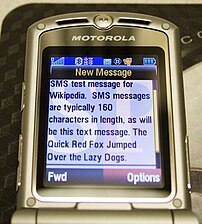 Image via Wikipedia
Image via Wikipedia Text messages continue to impress and confound (a recent use for announcing a vice-presidential pick is a good example). Today, texting has evolved (thank to Twitter and others) into networked microblogging.
A new book by David Crystal entitled “txtng: the gr8 db8” brings data and a healthy dose of reality to the subject.
For instance, I was surprised to learn that in 2006 text services generated $70 billion in revenues, 3 times the total box office for all Hollywood studios that year.
Let that sink in. Text messaging generates 3x the revenue of Hollywood’s box office movies.
Most of Crystal’s book centers around misperceptions. A recent entry on the Oxford University Press blog discusses the myths of texting in a review of a book. Two of these myths include:
- Texting is damaging literacy and the language — this is not true, and Crystal does a good job of showing how text abbreviations and practices are often the same as those used everyday, and also how lucid the users can be wielding the new medium (poetry contests, cell novels, etc.).
- Texting is for teenagers — while teens are still the majority of texters, many have grown up, and are now in their 20s. In addition, people of all ages text. It’s not just for kids, and the prevalence among kids drives both the short-term adoption by older people and the long-term adoption as people age.
A particularly fascinating aspect of the book is the examination of texting in languages other than English, including a glossary of non-English abbreviations. It is truly a universal form of communication.
Another fascinating fact: in one study, cell phone users averaged 20 calls per month, and 28 text messages.
See you on Twitter.
![Reblog this post [with Zemanta]](http://img.zemanta.com/reblog_e.png?x-id=89a958f2-819a-4378-986f-6d4578409348)


